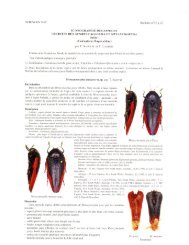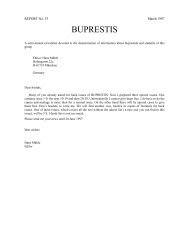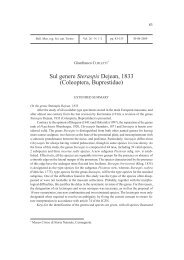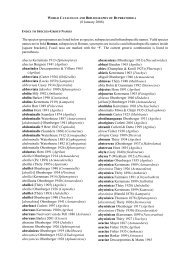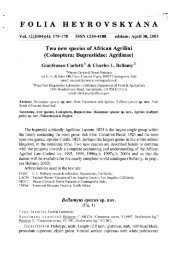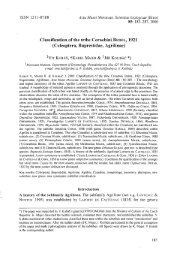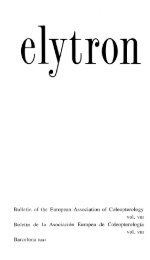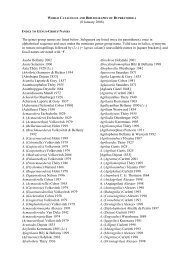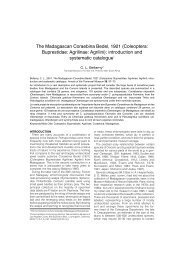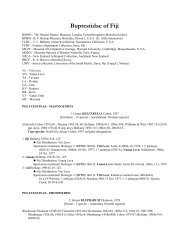A NEW SPECIES OF ACMAEODERA (COLEOPTERA ...
A NEW SPECIES OF ACMAEODERA (COLEOPTERA ...
A NEW SPECIES OF ACMAEODERA (COLEOPTERA ...
You also want an ePaper? Increase the reach of your titles
YUMPU automatically turns print PDFs into web optimized ePapers that Google loves.
A <strong>NEW</strong> <strong>SPECIES</strong> <strong>OF</strong> <strong>ACMAEODERA</strong><br />
(<strong>COLEOPTERA</strong>: BUPRESTIDAE)'<br />
I I August 1980<br />
PAN-PACIFIC ENTOMOLOGIST<br />
July 1980, Vol. 56, No. 3, pp. 175-180<br />
College of Osteopathic Medicine of the Pacific, Pomona, California 91766<br />
The type series of Acmaeodera discalis Cazier (1940) included the holo-<br />
type male from Arizona, Gila Co., Pinal Mts. [AMNH] and 2 female para-<br />
types from Texas, El Paso. More material has been collected from Arizona,<br />
Texas, and Coahuila, and the female genitalia reveal 2 distinctively different<br />
forms. The population from Texas and Coahuila, including the 2 female<br />
paratypes of A. discalis, is described as a new species.<br />
Abbreviations for collections [brackets] are as listed by Arnett and Sam-<br />
uelson (1969) except for the collections of W. F. Barr = WFBC and D. S.<br />
Verity = DSVC. Appreciation is extended to W. F. Barr, Univ. of Idaho,<br />
R. L. Westcott, Oregon Dept. of Agric., Salem, and to the publications<br />
committee of the Division of Plant Industry, Florida Dept. of Agric. and<br />
Consumer Services, for helpful comments on the manuscript; and to the<br />
following for the loan of specimens: W. F. Barr; F. M. Beer, Corvallis,<br />
Ore.; Lee H. Herman, AMNH; E. H. Smith, FMNH; J. W. Tilden, San<br />
Jose, Calif.; D. S. Verity and G. C. Walters, Los Angeles, Calif.; and R. L.<br />
Westcott.<br />
Acmaeodera riograndei, new species<br />
(Figs. 2, 4)<br />
Diagnosis.-Medium size, robust; pronotum and ventral body unicolo-<br />
rous aeneo-black; elytral disk yellow, cupreo-black or piceous along base,<br />
lateral and sutural margins and usually as small markings arranged longi-<br />
tudinally in middle of disk; prosternum with anterior margin slightly, ar-<br />
cuately retracted; apical abdominal sternite without subapical carina; ter-<br />
minal segment of female genitalia about as broad as long, less than 0.25 the<br />
length of elytra.<br />
Description, female holotype, Fig. 2.-Head with front feebly convex;<br />
densely shallowly punctate and clothed with semierect white setae; clypeus<br />
shallowly emarginate; antennae extending to just beyond middle of prono-<br />
tum, serrate from segment 5. Pronotum as wide as elytra, 1.9 times as wide<br />
as long; laterally bluntly angulate at basal third, converging obliquely to<br />
base and apex, constricted subapically; basal margin nearly straight, con-<br />
verging slightly forward; apical margin bisinuate with depressed border;
PAN-PACIFIC ENTOMOLOGIST<br />
FIG. 1. Acmaeodera discalis Cazier, female plesiallotype. Fig. 2. Acmaeodera riograndei<br />
Nelson, new species, female holotype (line = 5 mm for Figs. 1 and 2).<br />
surface convex, with feeble midline impression more evident basally and<br />
apically and with small deep fovea near base toward lateral angles; disk<br />
deeply, densely punctate, punctures denser toward margins; surface mod-<br />
erately clothed with short semierect white setae. Elytra with lateral margins<br />
diverging for short distance from base, then subparallel to middle and round-<br />
ly converging to blunt apex; margins serrate in apical 0.66; stria1 punctures<br />
deep and moderately large; each interstrial space with single row of setal-
VOLUME 56, NUMBER 3<br />
3<br />
Fig. 3. A. discalis, female genitalia. Fig. 4. A. riograndei, female genitalia (line = 2 mm<br />
for Figs. 3 and 4).<br />
bearing punctures. Beneath, densely punctate, with semirecumbent white<br />
setae.<br />
Genitalia, Fig. 4, with membranous apical segment (coxite, according to<br />
Tanner, 1927) almost as wide as long, elytra more than 4 times as long as<br />
coxite.<br />
Length 7.7 mm; width 2.8 mm. .<br />
Male, al1otype.-Similar to female, but differs as follows: slightly less
178 PAN-PACIFIC ENTOMOLOGIST<br />
robust; dark markings on disk of elytra less extensive, extending from base<br />
only 0.4 distance to apex; antennae slightly longer, with segments larger.<br />
Length 6.5 mm; width 2.4 mm.<br />
Type material.-Holotype [USNM 757541, Texas, ~rewster Co., Big<br />
Bend National Park, W side of Chisos Mts., Oak Springs, 24 June 1971, G.<br />
H. Nelson, on Cirsium sp. blossom; allotype [USNM] and 6 female para-<br />
types, type locality, 25 June 1971, G. H. Nelson, on Cirsium sp. blossoms.<br />
Other paratypes.-8 females, 6 males, same data as holotype; 1 female,<br />
3 males, same data except 1 July 1963; 1 female, same data except 20 June<br />
1965; 4 females, 1 male, type locality, 30 June 1963, and 1 male, 1 July 1963,<br />
F. M. Beer, Cirsium sp. blossoms; 1 female, Big Bend National Park, 5 km<br />
E of Panther Junction, 26 June 1963, G. H. Nelson and family, on yellow<br />
composite blossom; 1 female, Big Bend National Park, Castolon, 18 July<br />
1967, J. W. Tilden; I female, 1 male, Big Bend National Park, Basin, 15<br />
June 1948, M. Cazier; 2 males, same place, 14 June 1948, M. Cazier; 1 male,<br />
same park, 9.7-14.5 km E of Panther Junction, 1 July 1972, R. L. Westcott;<br />
1 female, 22.6 km W of Panther Junction, 5 July 1961, P. D. Christenson;<br />
2 females, Texas, El Paso (part of type series of A. discalis). Mexico. Coa-<br />
huila: 1 female, l male, Guadalupe, 24 May 1952, M. Cazier, W. Gertsch,<br />
R. Schrammel; 1 female, Paila, 1156 m, 21 August 1947, Spieth; 5 females,<br />
1 male, LaRosa, 1603 m, 22 August 1947, Spieth, Gertsch, Michener. Para-<br />
types are in the following collections: AMNH, CASC, FMNH, FSCA,<br />
WFBC, RLWE, DSVC, FMBC, GCWC, GHNC, JWTC.<br />
Variation.-There is considerable variability in the extent of the dark<br />
markings on the yellow elytral discal area in A. riograndei. The females are<br />
generally more heavily maculated with dark discal spots, 32 with and 2 with<br />
none. Of the males, 9 have discernible discal maculations and 9 do not.<br />
Females vary from 6.5 to 7.8 mm long and 2.3 to 3.0 mm wide; males from<br />
6.0 to 6.8 mm long and 2.0 to 2.7 mm wide.<br />
Biology.-Larval habits are unknown, and adult habits are included under<br />
type material.<br />
Comparison.-This species belongs in the truncate group and will key to<br />
Acmaeodera quudrivittata Horn in Fa11 (1899). It can be separated from A.<br />
quadrivittata by its larger size, and the pronoturn which has more angulate<br />
side margins and is more densely punctate. A. riograndei is superficially<br />
similar to Acmaeodera discalis Cazier but differs as follows: body usually<br />
more robust with elytra more blunt apically and yellow discal area with dark<br />
markings arranged longitudinally from humeral unbone toward apex (dark<br />
discal markings present in only 9 of 32 A. discalis examined); female gen-<br />
italia with coxite about as broad as long in A. riograndei but more than 1.5<br />
times as long as broad in A. discalis. On the basis of the female genitalia,
*<br />
VOLUME 56, NUMBER 3 179<br />
A. riograndei appears more closely related to A. quadrivittata than to A.<br />
discalis in spite of the close superficial resemblance to the latter.<br />
Acmaeodera discalis Cazier<br />
(Figs. 1, 3)<br />
The original diagnosis and description (Cazier, 1940) refer to the holotype<br />
male only, so the male will not be redescribed. Since the 2 original female<br />
paratypes belong to A. riograndei, female characteristics of A. discalis will<br />
be redefined.<br />
Description, female plesial1otype.-Differs from male as follows: anten-<br />
nae shorter, reaching 0.66 the distance to hind angles of pronotum; genitalia<br />
with coxite more than 1.5 times as long as wide and more than 0.25 the<br />
length of elytra.<br />
Length 7.4 mm; width 2.7 mm.<br />
Plesiallotype [GHNC] from Arizona, Pinal Mts., top of Sixshooter Can-<br />
yon, elev. 2286 m, 30 August 1959, G. H. Nelson, on lavender composite.<br />
Variation.-Of the 32 A. discalis examined, only 9 had any dark discal<br />
markings on elytra. They varied in size from 6.4 to 9.0 mm long and 2.3 to<br />
3.3 mm wide.<br />
Geographical distribution.-Central and southeastern Arizona. Type lo-<br />
cality: Gila co., Pinal Mts. Other localities in Arizona, from which material<br />
has been seen, include: Coconino Co., Oak Creek Canyon, 1-18 August,<br />
D. J. & J. N. Knull [FMNH]; Gila Co., Payson, September 1962 [GHNC];<br />
Pima Co., Santa Catalina Mts., Molino Basin, 20 August 1953, G. M. Bradt<br />
[WFBC]; same place, 23 August 1952, G. M. Bradt [AMNH]; Santa Catalina<br />
Mts., Sabino Canyon, 6 September 1964, G. C. Walters; Pima Co., Rincon<br />
Mt., 16 September 1937, E. D. Ball [WFBC]; Cochise Co., Huachuca Mts.,<br />
Miller's Canyon, 12 August 1961, GHN, on rock [GHNC]; Huachuca Mts.,<br />
24 July to 9 September, D. J. & J. N. Knull [FMNH]; Cochise Co., Palmerly<br />
[Palmerlee], June [AMNH]; Sixshooter Canyon, near Globe, 17 August<br />
1958, R. L. Westcott [RLWE].<br />
Biology.-The larval habits are unknown, and scant data on adults indi-<br />
cate they have been taken alighting on rocks and on lavender composites.<br />
Comparison.-The superficial resemblance to A. riograndei is discussed<br />
under that species. On the basis of the female genitalia, A. discalis is most<br />
closely related to Acmaeodera cazieri Knull. The latter is similar in size<br />
and form but can be readily separated from A. discalis as follows: pronotum<br />
and ventral body black with bluish tint, and light color on elytra reduced to<br />
vittae.
180 PAN-PACIFIC ENTOMOLOGIST<br />
Literature Cited<br />
Arnett, R. H., Jr., and G. A. Samuelson (eds.). 1969. Directory of Coleoptera collections of -<br />
North America (Canada through Panama). Purdue Univ., Lafayette, Indiana, 123 pp.<br />
Cazier, M. A. 1940. New North American Acrnaeodera, with synonymical and miscellaneous<br />
notes on other species (Co1eoptera:Buprestidae). The Wasmann Collector, 4(1): 17-29. L-<br />
Fall, H. C. 1899. Synopsis of the species of Acrnaeodera of America, north of Mexico. J.<br />
N.Y. Entomol. Soc., 7(1): 1-37.<br />
Tanner, V. M. 1927. A preliminary study of the genitalia of female Coleoptera. Trans. Amer.<br />
Entomol. Soc., 53:s-50.<br />
Footnotes<br />
Contribution No. 437, Bureau of Entomology, Division of Plant Industry, Florida Depart-<br />
ment of Agriculture and Consumer Services, Gainesville, FL 32602.<br />
Research Associate, Florida State Collection of Arthropods, Division of Plant Industry,<br />
Florida Department of Agriculture and Consumer Services.



